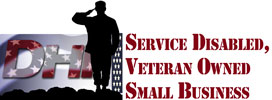DHi Proclaims "The Year of Building Safety"
NEW YORK (February 13, 2006) — In a recent issue of the New York Real Estate Journal, DHi offered their predictions and prognostications for 2006 — which they have dubbed "The Year of Building Safety." They’re referring, of course, to New York City's transformative new Local Law 26/04 which mandates, in part, the installation of photoluminescent (PL) — or "glow-in-the-dark" — signage for all Class E commercial high rise buildings by July 1, 2006.
DHi's assessment was provided by Richard J. Martin, President and CEO of Defense Holdings, inc. (DHi), and A. Martin Erim, Business Affairs Director, AfterGlow Technologies, Inc., a wholly-owned subsidiary of DHi. "As a result of the tragedy of 9/11 and the big blackout of August 14, 2003," they state, "everyone involved with commercial building issues — architects, engineers, property managers, owners, and city officials — gained an increasing awareness of just how critical safety and security measures have become in the 21st century."
They note that Local Law 26 takes a huge step toward a future where photoluminescent (PL) safety systems are standardized and codified, not to mention made reliable. Once regarded as a novelty, PL is coming into its own as the preferred way to guide people out of a stricken building, whether the emergency involves a massive electrical power outage, an explosion and fire of unknown origin, or even another terrorist attack. They point out that "New York has grabbed hold of this issue in its new statute, and has begun to set the standards for the future. Just as children growing up in the 1950s routinely went through "duck and cover" drills to prepare for a possible nuclear attack, we can see a day when today's workers and children will learn to look routinely for PL guidance systems in stairwells and public walkways in the event of a building emergency."
Martin and Erim think New York City will set the safety standards for cities around the world in the years to come. For this reason, they noted that the building and building management industries will be closely watching how the new law is implemented and how leading-edge property owners and managers — concerned about the safety and security of their valued tenants — respond as PL materials are integrated into Class E building stairwells.
They also observe that surprises are likely to pop up in 2006 as the massive implementation efforts under the new law reach critical mass. Manufacturers understand the new requirements. But are adequate products available and in sufficient quantity? More importantly, are vendors and installers fully ready to confront the variables in each installation? Today's leading-edge new materials are proven to work well. But will the installed materials fall off the wall in 6 months? What if it's installed wrong? Will contractors and architects fully understand the large spec? Will the upcoming blizzard of RFPs reflect understanding or confusion?
Technical issues won’t be the only thing in play as New Yorkers race toward the July 1 installation deadline. Timely compliance on such a massive scale will require quick action, and procrastination won't be an option. Aside from the materials and their installation, a host of other problems are involved, including project management, logistics, inventory, and, of course, cost and quality. As is always the case in the building trades, installing the best materials with the cheapest techniques to save money up front may prove to be a long-term problem in the future. Already, a few "fly-by-night" vendors have showed up on the scene, complicating the issue for building management officials who'll have to work extra hard in order to find a vendor who'll offer first rate materials and installation and back them up with a solid guarantee such as the one offered by DHi's AfterGlow Technologies.
Looking not too far ahead, Martin and Erim said that they "expect similar requirements are in the offing for residential high-rise buildings. Further in the future, we foresee an increasing interest in PL safety solutions at hotels, hospitals, nursing homes, schools, and a variety of other public and commercial buildings."
They also noted that standards can and do evolve, pointing out an interesting development in the ongoing installation of PL materials at the Department of Energy in Washington, DC. There, the agency specified that AfterGlow Technologies-installed PL systems also be stamped with Braille exit instructions. At first, this might seem odd, since most visually impaired people won't actually be able to see the PL materials. "But it's not a problem if all employees are taught that Braille signage will always appear in the same place on a stairwell or exitway, allowing even the visually impaired to feel their way out of danger in an emergency," Martin and Erim point out.



